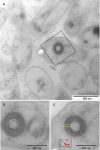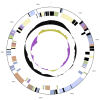Genome of the R-body producing marine alphaproteobacterium Labrenzia alexandrii type strain (DFL-11(T))
- PMID: 24019989
- PMCID: PMC3764935
- DOI: 10.4056/sigs.3456959
Genome of the R-body producing marine alphaproteobacterium Labrenzia alexandrii type strain (DFL-11(T))
Abstract
Labrenzia alexandrii Biebl et al. 2007 is a marine member of the family Rhodobacteraceae in the order Rhodobacterales, which has thus far only partially been characterized at the genome level. The bacterium is of interest because it lives in close association with the toxic dinoflagellate Alexandrium lusitanicum. Ultrastructural analysis reveals R-bodies within the bacterial cells, which are primarily known from obligate endosymbionts that trigger "killing traits" in ciliates (Paramecium spp.). Genomic traits of L. alexandrii DFL-11(T) are in accordance with these findings, as they include the reb genes putatively involved in R-body synthesis. Analysis of the two extrachromosomal elements suggests a role in heavy-metal resistance and exopolysaccharide formation, respectively. The 5,461,856 bp long genome with its 5,071 protein-coding and 73 RNA genes consists of one chromosome and two plasmids, and has been sequenced in the context of the Marine Microbial Initiative.
Keywords: Alexandrium lusitanicum; Alphaproteobacteria; aerobe; dinoflagellates; high-quality draft; motile; photoheterotroph; symbiosis.
Figures





Similar articles
-
Genome of the marine alphaproteobacterium Hoeflea phototrophica type strain (DFL-43(T)).Stand Genomic Sci. 2013 Feb 25;7(3):440-8. doi: 10.4056/sigs.3486982. eCollection 2013. Stand Genomic Sci. 2013. PMID: 24019991 Free PMC article.
-
Description of Labrenzia alexandrii gen. nov., sp. nov., a novel alphaproteobacterium containing bacteriochlorophyll a, and a proposal for reclassification of Stappia aggregata as Labrenzia aggregata comb. nov., of Stappia marina as Labrenzia marina comb. nov. and of Stappia alba as Labrenzia alba comb. nov., and emended descriptions of the genera Pannonibacter, Stappia and Roseibium, and of the species Roseibium denhamense and Roseibium hamelinense.Int J Syst Evol Microbiol. 2007 May;57(Pt 5):1095-1107. doi: 10.1099/ijs.0.64821-0. Int J Syst Evol Microbiol. 2007. PMID: 17473266
-
Genome sequence of the Roseovarius mucosus type strain (DSM 17069(T)), a bacteriochlorophyll a-containing representative of the marine Roseobacter group isolated from the dinoflagellate Alexandrium ostenfeldii.Stand Genomic Sci. 2015 Mar 19;10:17. doi: 10.1186/1944-3277-10-17. eCollection 2015. Stand Genomic Sci. 2015. PMID: 26203330 Free PMC article.
-
Ponticoccus alexandrii sp. nov., a novel bacterium isolated from the marine toxigenic dinoflagellate Alexandrium minutum.Antonie Van Leeuwenhoek. 2018 Jun;111(6):995-1000. doi: 10.1007/s10482-017-0996-2. Epub 2017 Dec 12. Antonie Van Leeuwenhoek. 2018. PMID: 29234985
-
R-body-producing bacteria.Microbiol Rev. 1989 Mar;53(1):25-67. doi: 10.1128/mr.53.1.25-67.1989. Microbiol Rev. 1989. PMID: 2651865 Free PMC article. Review.
Cited by
-
Principles of plastid reductive evolution illuminated by nonphotosynthetic chrysophytes.Proc Natl Acad Sci U S A. 2019 Apr 2;116(14):6914-6923. doi: 10.1073/pnas.1819976116. Epub 2019 Mar 14. Proc Natl Acad Sci U S A. 2019. PMID: 30872488 Free PMC article.
-
Comparative Genomics Highlights Symbiotic Capacities and High Metabolic Flexibility of the Marine Genus Pseudovibrio.Genome Biol Evol. 2018 Jan 1;10(1):125-142. doi: 10.1093/gbe/evx271. Genome Biol Evol. 2018. PMID: 29319806 Free PMC article.
-
Microbial dynamics during harmful dinoflagellate Ostreopsis cf. ovata growth: Bacterial succession and viral abundance pattern.Microbiologyopen. 2018 Aug;7(4):e00584. doi: 10.1002/mbo3.584. Epub 2018 Feb 27. Microbiologyopen. 2018. PMID: 29484854 Free PMC article.
-
Complete Genome Sequence of Labrenzia sp. Strain CP4, Isolated from a Self-Regenerating Biocathode Biofilm.Genome Announc. 2016 May 12;4(3):e00354-16. doi: 10.1128/genomeA.00354-16. Genome Announc. 2016. PMID: 27174270 Free PMC article.
References
-
- Biebl H, Pukall R, Lünsdorf H, Schulz S, Allgaier M, Tindall BJ, Wagner-Döbler I. Description of Labrenzia alexandrii gen. nov., sp. nov., a novel alphaproteobacterium containing bacteriochlorophyll a, and a proposal for reclassification of Stappia aggregata as Labrenzia aggregata comb. nov., of Stappia marina as Labrenzia marina comb. nov. and of Stappia alba as Labrenzia alba comb. nov., and emended descriptions of the genera Pannonibacter, Stappia and Roseibium, and of the species Roseibium denhamense and Roseibium hamelinense. Int J Syst Evol Microbiol 2007; 57:1095-1107 10.1099/ijs.0.64821-0 - DOI - DOI - DOI - DOI - DOI - DOI - DOI - DOI - DOI - DOI - DOI - DOI - DOI - PubMed
-
- Garrity GM, Bell JA, Lilburn T. Order III. Rhodobacteraceae fam. nov. In: Garrity GM, Brenner DJ, Krieg NR, Staley JT (eds), Bergey's Manual of Systematic Bacteriology, Second Edition, Volume 2, Part C, Springer, New York, 2005, p. 161. - DOI
-
- Lee KB, Liu CT, Anzai Y, Kim H, Aono T, Oyaizu H. The hierarchical system of the ‘Alphaproteobacteria’: description of Hyphomonadaceae fam. nov., Xanthobacteraceae fam. nov. and Erythrobacteraceae fam. nov. Int J Syst Evol Microbiol 2005; 55:1907-1919 10.1099/ijs.0.63663-0 - DOI - DOI - DOI - DOI - DOI - PubMed
-
- Altschul SF, Gish W, Miller W, Myers EW, Lipman DJ. Basic local alignment search tool. J Mol Biol 1990; 215:403-410 - PubMed
-
- Korf I, Yandell M, Bedell J. BLAST, O'Reilly, Sebastopol, 2003.
LinkOut - more resources
Full Text Sources
Other Literature Sources
Molecular Biology Databases
Miscellaneous

